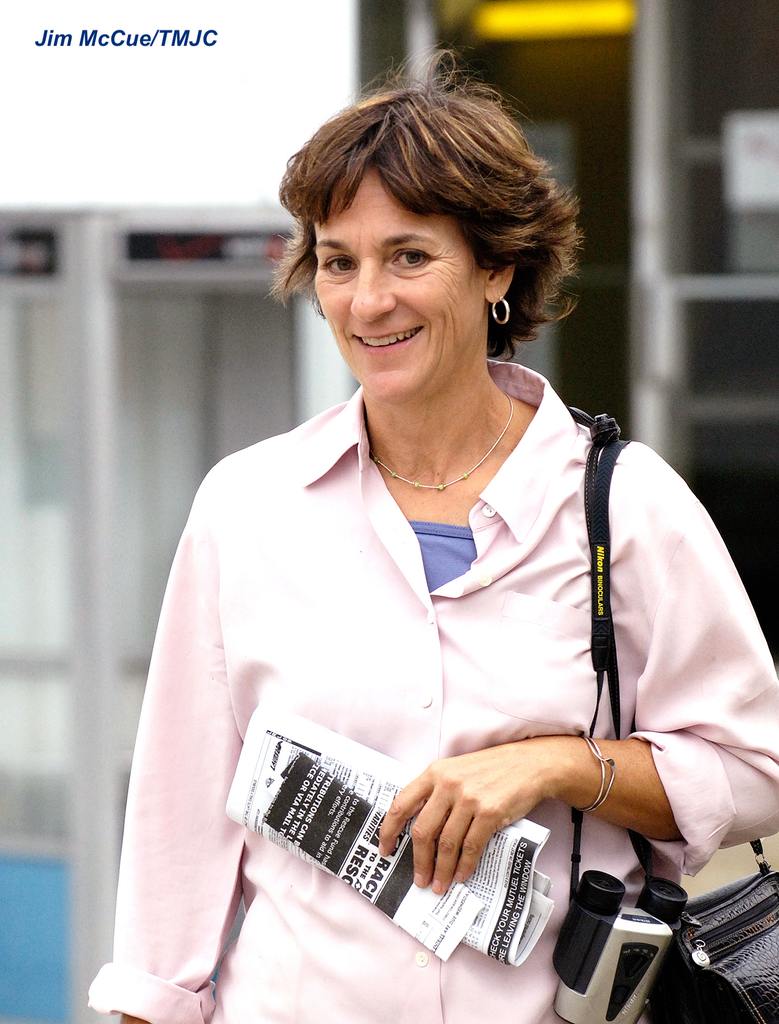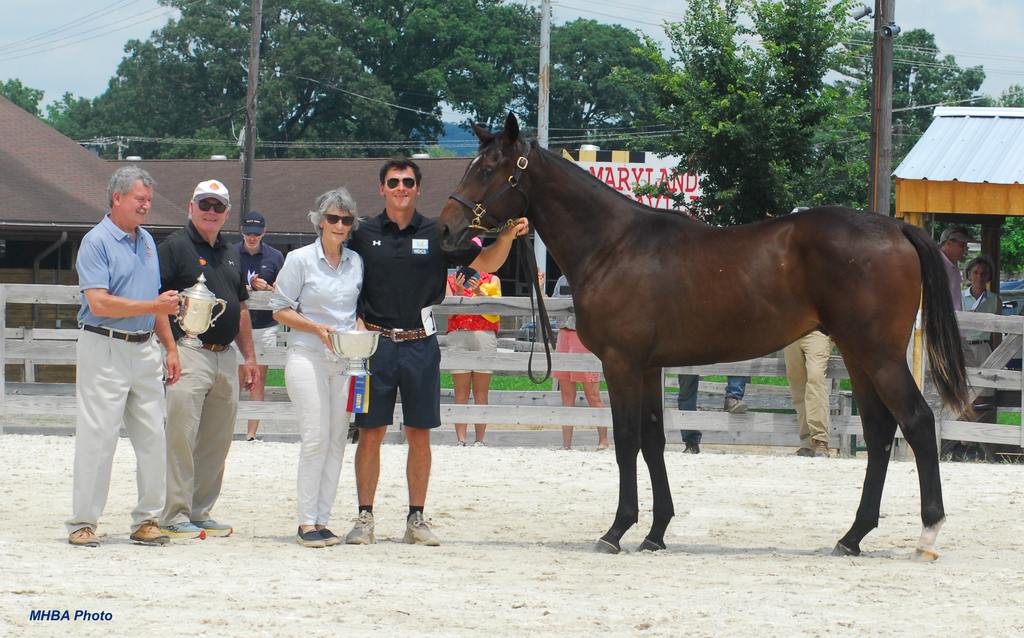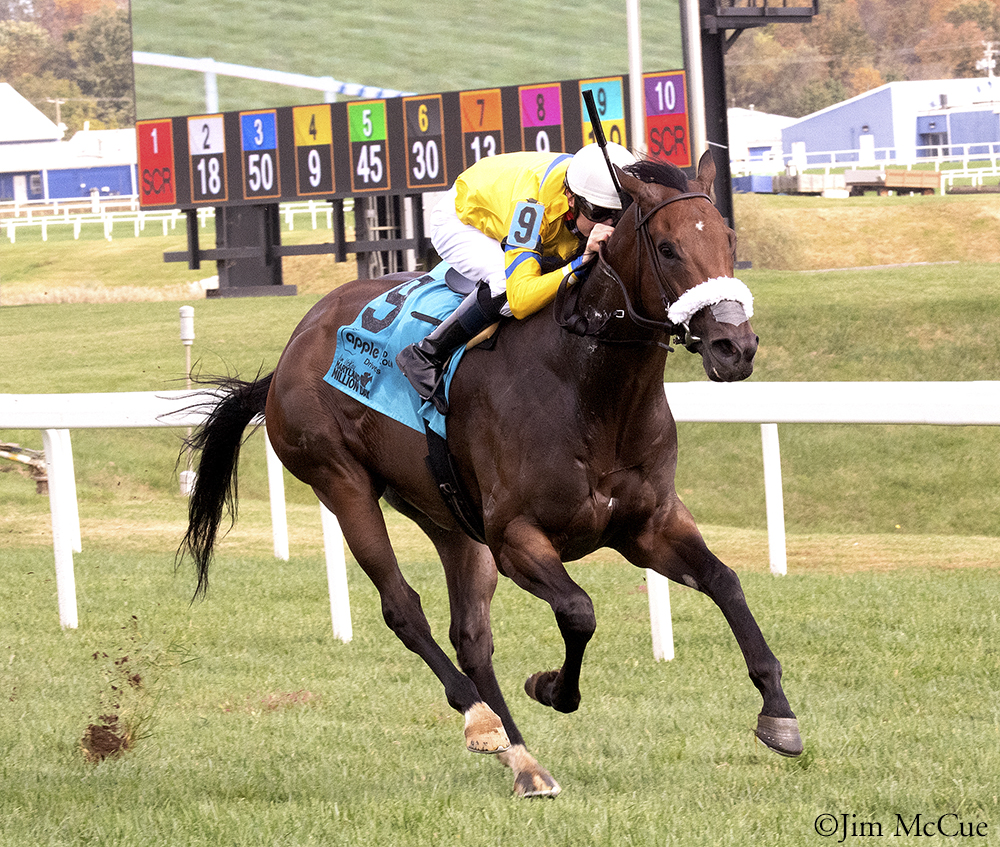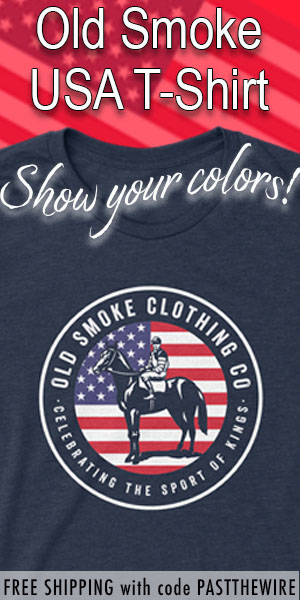
Ann Merryman. (Jim McCue/TMJC)
A Day with Ann Merryman
By Mackenzie Pfeiffer
Ann Merryman made headlines this summer when her stunning homebred colt by Great Notion out of Sista won top honors at the Maryland Horse Breeders Association’s annual Yearling Show. The colt is a half-brother to stakes-winner Fiya.
Longtime Mid-Atlantic racing fans know it was no fluke. Over five decades, Merryman has quietly built a career defined by practical horsemanship, ethical training, and a deep, intuitive understanding of the animals in her care.
We sat down over pizza last weekend to watch the Jim Dandy Stakes. Ann doesn’t romanticize racing. She’s pragmatic, understated, and unflinchingly honest. Yet when she speaks about her horses, her training philosophy, and the rhythm of a good gallop, one can feel that the romance is still there. Not in sentiment, but in something stronger. Devotion, curiosity, and a love of the game that hasn’t faded in fifty years.
Mackenzie Pfeiffer: They’re in the gate for the Jim Dandy – who do you like? Oh, and they’re off.
Ann Merryman: (As the horses reach the top of the stretch) Is that Sovereignty on the outside? Oh wow… look at that. He just breathes different air.
MP: We’ve seen some of the best 3-year-olds in the country today. How about the best yearling in Maryland? How’s your colt?
AM: He’s great. I really like him a lot. Honestly, I never planned to show him. I’ve never taken one to the yearling show before. He just needed another challenge mentally, I mean. He’s super smart, and I felt like I needed to keep giving him new experiences to keep things interesting. He’s lovely now, but he wasn’t always easy. I’ve never seen my vet back out of a stall before, but back in March, he squished her and my son against the wall. Not in a mean way, just evasive. Like when he leans into the other colt in the field when they play. I told Miguel, my guy in the barn, “We need to start working with him!” A few weeks later, Miguel broke his foot, so I thought, oh jeez, it’s up to me now.

MP: You’ve come a long way. How did you go about it?
AM: I just started tinkering with him. I’d put him on the walker and teach him how to be a horse. He’s so freaking smart – he was just bored. He loved having things to do. One day, Suzanne (Stettinius) had her trailer parked with the ramp down. I was walking him to the barn and decided to show him the trailer first. He just walked right on. No feed, no coaxing. I worried he’d panic at the noise and try to jump off, but he just turned around and walked right down. I thought, oh my gosh, that was fun. That’s when I realized I should show him. He has such a good mind.
MP: A good-minded horse makes the training so much fun. How did he handle the show atmosphere?
AP: He was great. He’s just a nice, classy horse. That morning, someone jokingly asked if I was cheating because I gave him a spin around the ring to see the tent. I thought I’d be showing him myself and didn’t want him to spook and step on me! It never even occurred to me how people usually prepare for these shows. I put him on the walker a few times, walked him in the field, gave him a bath that morning. We were just there for the experience.
MP: He’s out of Sista, who you trained and co-bred. Is it nice to see this come full circle?
AM: I was lucky. I trained for my cousin Laura. She had a Smarten mare, and I had a cover for Two Punch. That was the cross everyone wanted, so we co-bred Sista. She couldn’t really run. I think she made $8,000. I had no intention of breeding her, but I just kept her around. I don’t breed my mares like rabbits every year. I like to see what they produce before I have too many coming along. Sista would foxhunt for a season, then come back to the farm. Everyone here loved her.
MP: I forgot she hunted! Did Fiya’s success keep Sista in the broodmare barn?
AM: Yes. When Fiya hit it out of the park, I decided to keep going. The full sister is nice, but not quite Fiya. The Friesan Fire foals have all been a bit hot and spicy. I’m not sure why it took me so long to go to Great Notion. Sista had a terrible time foaling this colt. He was huge! Grace and Louis (Merryman) get all the credit. They call him the “buggy foal” because he was stuck so long, they thought they’d need a Polaris to get him out. It’s a miracle he made it.
MP: You’re out of a stakes-producing mare yourself. How did your path to training differ from your siblings?
AM: We all gravitated towards it with slightly different experiences along the way, but we all helped each other as well. I wasn’t a straight-A student. I’m not very competitive – I just love horses. I wanted to train ethically and still make a living. I freelanced and galloped 20 horses a day. I remember a trainer asking me to take a two-year-old to the gate in company the day before it debuted. No one else had even been on them. We were supposed to hustle them across the chute four or five times. I remember thinking, I’ll probably never get a great horse, but I can pay my BGE bill doing this. So, I started saving to buy a horse and do it my way.
MP: It can be a tough game. What kept you going?
AM: I just like playing with horses. I never cared about being famous. Just seeing them learn, solving problems, figuring out how to run, how to jump, how to handle life. That excitement hasn’t changed in 50 years.
MP: It’s one thing to train horses you’ve raised, but you were just as successful with horses you claimed. How did that fit into your program?
AM: I don’t know if I deserve much credit. I got lucky. But it was fun, like solving a Rubik’s Cube. I told a friend once, “If you’re feeling down, just go shopping at Laurel. It’s more fun than the mall.”
MP: I’ve heard you watched every horse on the track and kept mental notes. Did you have a system?
AM: It’s harder now to find a horse that hasn’t tried turf, but I bought my house thanks to one I claimed for that reason. Looking back, my success came from how I trained. Utilizing the farm in combination with training at the track helped get them fit without speed. Climbing hills took pressure off of their legs until they were ready to have a breeze at the track and run. The horses already had talent. They were just sore or needed time. You can’t make a horse faster or more talented. They are who they are.
MP: Speaking of time – Grapeshot had two years off before winning a Grade 3. Were you surprised?
AM: An owner gave me the Tattersalls catalogue and said, “Find me a horse. I want a Goldminer’s Dream.” I wasn’t going to outsmart the Irish lads. But I found Grapeshot. He’d been stakes-placed, and something in his page rang a bell. The catalogue even said the suspensory was detached from the bone. We took a shot.
He wasn’t easy – spooky, wheeled around, wore every piece of tack in the barn. I finally lined up a turf work with company, but the company bailed. I told the rider, “Do what you can – stay safe. He’ll probably stop.” Well, I’ve never seen anything like it. He hit the pole and just looked like a glider plane. The owner asked how it went. I said, “This horse breathes different air. No way he doesn’t win.”
MP: Wow. I’ve never heard you speak so confidently about a horse. What made the work so impressive?
AM: It was just… different. If you’d seen it, you’d never forget it. He looked like a glider. Dirt training had thrown him off after being overseas. He needed to adjust. After racing, I went on to hunt him myself. When I put a stick on him, I couldn’t believe his size. He was so well made and balanced, a true class horse.
MP: You’ve always paid attention to pedigree. If you could breed one of yours to any stallion for $1, who would it be?
AM: So many options… probably Flightline. He was just a different kind of horse. I’m excited to see how his foals run.
MP: Did you have any “non-negotiables” in a horse?
AM: I hate windy horses. Some people manage them just fine, but I’ve always struggled with it. That said, the procedures have improved a lot. Still, can they ever truly be at their best?
MP: You gave apprentice riders a lot of opportunities. What drew you to working with bugs?
AM: I love bug riders when they can really ride. Look at the ones we had come through Maryland in the last 50 years: Edgar Prado, Kent Desormeaux, Rosie Napravnik, Chris McCarron, just to name a few. I had the pleasure of riding all of them and more. They would make anyone love bug riders. Rosie won a lot of races for me. I once said I’d rather ride her than anyone in America. Trevor McCarthy’s work ethic amazed me. He’d hit the quarter pole and make the impossible happen.
Kent once saw a filly acting up in the paddock. He asked if I wanted him to grab an ear. I thought he was joking. But he calmly caught her and had her reeled in. I thought, oh my gosh, a horseman – and he has seven pounds?
I often told the bug riders that most of these horses are right-lead horses. Don’t force them around the turn. Just hold them together. You’ll only lose half a length, but when they switch leads with confidence in the lane? You might actually run on for a piece. And I needed every piece I could get.
I remember telling Mario Pino before the Maryland Million with Dr Detroit, “The owner has the mare and all the siblings. The best thing you can do is be third.” He gave the horse a breather from the three-eighths to the quarter pole, snuck up the rail, and beat a 1-5 shot by a nose. Best orders ever. Ride to be third.
MP: When reading the Form, what’s one angle you always consider?
AM: Owner percentage. Way more telling than trainer percentage. Why can’t we include that in the program? If you looked at my record with horses I owned and trained, it’d be much higher. I wasn’t better. I could just place them where they belonged. As for what’s already there, pedigree. I love to find horses that haven’t tried what I think they’re bred to do.
MP: We have to pay homage to Goldminer’s Dream. You campaigned him to earn over half a million and landed on the Breeders’ Cup extra list. Do you hope one of your own homebreds makes it there?
AM: I’d go to the Breeders’ Cup if I truly believed I could win. But honestly? If I owned a horse like that, I’d probably sell it, then find another one to bring along. I never cared about the spotlight. I just like playing with horses.
MP: Ha! Fair enough. Now that you’ve stepped into a different role, what have you learned?
AM: I’m more objective about a horse’s value or potential. When you’re in it, you try everything to make it work. Now I’d call it sooner. I’m also better at appraising them. When it was my job, I was always pushing. Now I have clarity, and that makes me a better partner to people like Suzanne, who can take the feedback without getting her feelings hurt.




